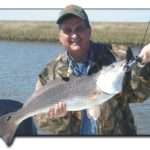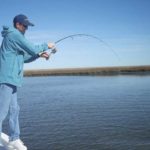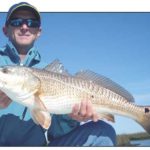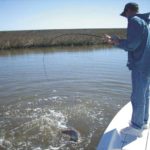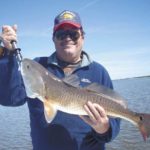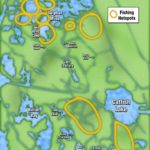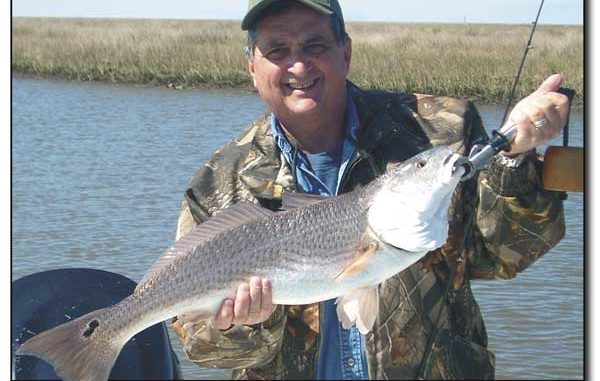
Brisk April winds can make this area’s trout tough to get to, but the reds are always willing and able.
April is the tail end of the dreaded transition period, according to Capt. Chad Dufrene (985-637-6357).By now, the weather has definitely changed, and temperatures are established in a solid spring pattern. Water temperatures will continue to rise from now through August, and easterly and southerly winds become the norm rather than the exception.
Small bait shrimp will start showing up this month in the bigger lakes and bays, and anglers should begin to see some action out there under the birds, even though most of the trout will be small. This is that in-between, on-the-edge time when the best fishing of the year is knocking at the door, when those big heifer speckled trout are poised like horses at the starting gate and ready to spring when the buzzer sounds!
And the buzzer is ready to sound.
“The big challenge this month is the wind,” Dufrene said. “March and April tend to be our windiest months, making it difficult to get outside to even look for trout. You can get into some good action using shallow-swimming twitch baits or even topwater baits tossed around coastal islands and fished along shorelines, at points and over reefs, if the winds allow you to make the run out and explore a little.
“You might get a good calm day here and there, or you might just get a calm morning to attempt the run. But the challenge is trying to catch fish this month with consistency, and the best way to do that is not to stay home on windy days, but to chase redfish in the shallow ponds around Catfish Lake and the Sulphur Mine.”
I invited myself aboard Dufrene’s 24-foot Blazer Bay recently for a trip specifically to target redfish, and I drug an old friend, Perry Matulich, along for the ride. We met Dufrene at Rose’s new diner on the four-lane in Golden Meadow, and scarfed down some huge pancakes and coffee before setting out on a colder-than-expected morning.
After a chilly boat ride (memo to self: Always dress warmer than you think you need to), Dufrene killed the big outboard and put the trolling motor over the bow just before we entered a whole system of shallow ponds.
Tips and techniques
“Make sure you use caution whenever you enter or exit these ponds just off the main waterways,” he said. “Many of them have underwater flow pipes running from the nearby tank batteries, and if you hit them hard with your prop or your lower unit, you’ll have an expensive trip to the Boat Doctor. If you choose to run into or out of a pond with the outboard, trim it up as high as feasible. But the best bet is to trim your outboard up and enter and exit using your trolling motor.”
Dufrene says it is especially wise to enter a pond you intend to fish using the trolling motor so as not to spook the fish.
“These ponds are very shallow, and the reds in them are easily spooked,” he said.
As a testimony to that, every now and then, we’d see little poofs of cloudy bottom just under the surface of the shallow water where redfish were spooked simply by the noise of the trolling motor and took off in a cloud of dust.
If the fleeing fish were close enough to cast toward, we gave it a try. The idea being, of course, to cast your bait in front of the running fish. The challenge is to get the bait close enough for the fish to see it but not so close as to conk him on the head and spook him.
The first few we spooked didn’t even give our baits a decent look, but as we moved into slightly deeper water, the fish became less skittish.
“There are several keys to look for when you fish a pond,” Dufrene said. “The first is water clarity. You don’t want the water either too dirty or too clear. Too dirty and the fish won’t see your bait at all. Too clear, and they see more than your bait — they’ll see your boat!”
If you were a fish, I guess a big boat hovering above your head could resemble a huge predator coming to devour you. The dumb redfish doesn’t know that it’s just a bunch of anglers up there who only want to hook him in the jaw, drag him out of the water and fillet him.
Dufrene says half a foot or so of underwater clarity is clean enough for redfish.
“Look for ponds with water clarity of at least 6 inches, and deep enough for you to float in using your trolling motor. If the pond has grass in it, that’s even better,” he said. “But grass is not a necessity. Clarity is a necessity, and deep enough water is a necessity.
“Ideally, you want to find water between 12 to 24 inches deep — 12 inches being the bare minimum because when the ponds are any shallower than that, you’ll have trouble floating in them and all you’ll do is spook the fish by churning up the bottom.”
The action that morning started slowly. The chilly weather may have made the fish sluggish early, but as the sun warmed things up, they definitely became more aggressive.
Dufrene perched atop the trolling motor bracket to get enough sight advantage so he could sight-cast to the fish sitting still in the water. Normally, whenever he fishes the redfish tournaments, he mounts a small platform on the bow to stand on. The added height enables him to look down into the water instead of trying to look across the surface where the glare from the sun is blinding.
He says that for any kind of sight-casting a good pair of polarized sunglasses is absolutely indispensable. He recommends and uses Costa Del Mars, a high quality and high-dollar investment that I’ve been reluctant to make.
Several years ago my wife bought me a nice pair of polarized sunglasses that blew off my face into the briny deep the very first time I wore them. After that, I was consigned to wearing $20 sunglasses in perpetuity as penance.
But eyesight is a precious thing, and anyone who spends a considerable amount of time on the water should take the plunge and buy a good pair. Invest in your eyesight (that’s what I’ll tell my wife, and I’ll let you know how it goes over).
But by standing atop the trolling motor bracket and adding a 6- to 8-inch height advantage, and by staring through a good set of polarized lenses, Dufrene saw what we couldn’t. He would point toward the shoreline and say, “Cast right there, 2 feet off the bank,” or “Cast here, or cast there.” We were “fishing blind,” but we’d cast where he pointed, and as often as not, we’d hook up with redfish. And these were big boys, averaging 9 to 12 pounds each.
I tried standing on my tip-toes on the back casting deck to try to see down into the water, but I never could see the shadows and spots Dufrene saw. He says that, depending on the water clarity, the bronze fish at times look only like dark spots under the surface.
Some of the dark spots we tossed to turned out to only be mud or oyster clumps, but some were redfish, and when our baits were tossed with some semblance of precision, they readily gobbled them up.
On several occasions we’d hit a bare stretch of shoreline where there were no signs of redfish or bait in the water. Dufrene would either troll out of those ponds or crank up the outboard and putt-putt to a deeper channel, and then move to another pond. You don’t beat a dead horse, and you don’t burn daylight beating a barren shoreline. So another key to success is simply to keep moving.
“Keep moving until you find them,” Dufrene said. “And when you catch one or you get a good thump, stick your Power Pole or Cajun anchor over, and see if there’s more than one. Anchors and chains are inadvisable in these shallow ponds due to the sheer noise and commotion. If you fish that area thoroughly and you get no more takers, start trolling again.”
Naturally, as we meandered through the ponds, we’d occasionally see the tell-tale V-wakes of running redfish, and we’d toss our baits ahead of them. Sometimes it resulted in a good hook-up, and other times they completely spurned our offerings, but always it was a thrill to put a bait just in front of a hungry predator.
Good bets for baits
Dufrene fished all morning with a glow-colored Berkley Gulp! Shrimp on a ¼-ounce plain jighead, tightlined, and the redfish ate it up. I fished with a purple/white Cocahoe, and had no trouble finding takers either. Big Perry tried a combination of baits, and met with equal success both tightlined and under a cork.
Dufrene says his redfish arsenal usually includes Bayou Buck ZZ spinners, gold spoons, soft plastics and Baby Minus-1 crankbaits.
“And if you can find live cocahoes, get them,” he said. “Live cocahoes will catch fish when nothing else will, so always buy them when they’re available. I consider them a ‘go-to’ bait on those difficult days when it’s hard to put fish in the boat.”
As a matter of preference and by seasoned experience on the tournament trail, Dufrene spools up all his reels with braided line.
“When you want to definitely land every possible fish, braid is the only way to go,” he said.
He uses 30-pound Spiderline because the larger-diameter line won’t dig into the spool after landing a big fish, and the product has proven to be durable and hardy.
Hotspots
The best action this month is the ponds all around the Sulphur Mine or to the south and southwest of Catfish Lake, Dufrene said. There are fish in other ponds that are on private property, and anglers should avoid those areas. But there is no scarcity of fish or of ponds to fish in, he said.
“Personally, I like to concentrate my efforts in the ponds farther to the north near the Sulphur Mine,” Dufrene said. “The water is more brackish, and those ponds generally have more grass. The grass can be a nuisance but it acts as a nursery for juvenile shrimp and crabs, which are a major source of food for redfish.
“I know some anglers who stay away from ponds with grass in them because it’s aggravating. It catches their hooks and clogs up the blade of the trolling motor, so they avoid them. I’m just the opposite. I look for ponds with grass, because where there is grass, you can bet there are reds — as long as the grass is not so thick that it just chokes the pond solid and makes it totally unfishable, I’ll try it.”
Capt. Chad Dufrene can be reached at (985) 637-6357.
